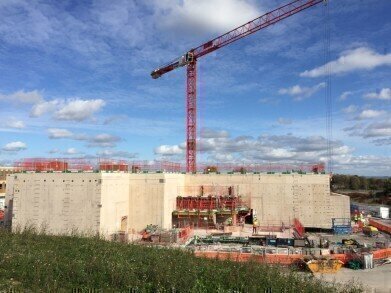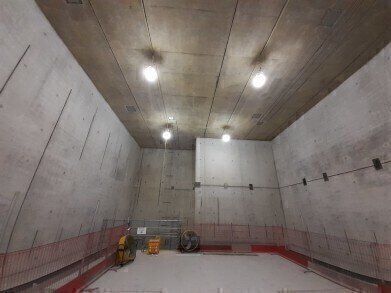-
 EPAC Side View
EPAC Side View -
 Large Target Area
Large Target Area
News & Views
Laser Technology to Advance Knowledge of Material Properties
Nov 20 2020
An advanced imaging facility at STFC ‘s Rutherford Appleton Laboratory (RAL) Oxfordshire, has started to take shape with the structural concrete pour for three key experimental areas and the laser source floor now complete. The Extreme Photonics Application Centre (EPAC), designed and hosted by Central Laser Facility (CLF) based at RAL on the Harwell Campus, will accelerate scientific understanding of high repetition laser-driven accelerators and sources.
Funded through UK Research and Innovation, EPAC includes two experimental areas with concrete walls 2.5 metres thick and a third experimental area with 2 metres thick walls, necessary to provide the shielding for the high energy experiments. These areas are all 8 metres tall.
To date more than 1,100 cement lorries have delivered 7,500m3 of low carbon concrete, to raise the new building from the ground. The mixture of 75% Ground Granulated Blast Furnace Slag (GGBS) instead of traditional Portland Cement, resulted in a 48% reduction in carbon footprint, a saving of 1,373 tonnes compared to normal practice.
The facility, expected to be operational in 2025, will undertake imaging of objects ranging from a piece of bone to complex structures like engines at previously unreachable levels of detail. Professor John Collier, Director of STFC’s Central Laser Facility, said: “EPAC will drive the development and application of a completely new class of compact accelerators and advanced sources of radiation based on lasers. We expect this to lead to a step change in a number of fields, for example the rapid, 3D imaging of complex or moving structures, or systems under load like engines or turbines. We’ve reached a very significant milestone for EPAC. I am delighted that this has been achieved on schedule whilst adhering to the necessary coronavirus controls, such as social distancing. This is a great credit to our construction partners, Mace.”
Experiments at EPAC will reach temperatures hotter than 50 million degrees Celsius, hotter than the centre of the sun. A single flash from the laser will be 1 quadrillion watt and its instantaneous output will be 10,000 times more powerful than the output of the UK national grid.
Robert Cocks, Project Director EPAC, Public Sector Construction at Mace, said: “We’re proud to work on such an ambitious and unique project, supporting our client’s ambition in driving sustainable concrete solutions. EPAC has one of the most technically challenging and complex concrete structures in Europe in 2020 and the result is testament to the strong commitment and expertise of everyone involved.’’
Funding is provided through the Government’s Strategic Priorities Fund (£71.2 million), with an additional investment of £10 million from the Ministry of Defence.
More information online
Digital Edition
Lab Asia 31.2 April 2024
April 2024
In This Edition Chromatography Articles - Approaches to troubleshooting an SPE method for the analysis of oligonucleotides (pt i) - High-precision liquid flow processes demand full fluidic c...
View all digital editions
Events
Apr 22 2024 Marrakech, Morroco
Making Pharmaceuticals Exhibition & Conference
Apr 23 2024 Coventry, UK
Apr 23 2024 Kintex, South Korea
Apr 23 2024 Seoul, South Korea
Apr 24 2024 Jakarta, Indonesia







.jpg)









